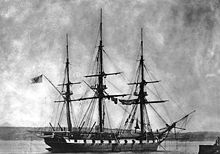Nix-class aviso

| |
| Class overview | |
|---|---|
| Builders | Robinson & Russell |
| Operators | |
| Preceded by | SMS Preussischer Adler |
| Succeeded by | SMS Grille |
| Built | 1850–1851 |
| In service | 1851–1865 |
| Completed | 2 |
| Retired | 2 |
| General characteristics | |
| Type | Paddle steamer aviso |
| Displacement | |
| Length | 53.85 m (176 ft 8 in) o/a |
| Beam |
|
| Draft | 2 m (6 ft 7 in) |
| Installed power | |
| Propulsion |
|
| Speed | 13 kn (24 km/h; 15 mph) |
| Range | 2,500 nmi (4,600 km; 2,900 mi) at 10 kn (19 km/h; 12 mph) |
| Complement |
|
| Armament | 4 × 25-pound mortars |
The Nix class was a pair of
Design
During the initial stage of the
Adalbert initially conceived of flat-bottomed steam
Characteristics
The Nix class ships were 53.05 m (174 ft 1 in)
The ships were propelled by a pair of 2-cylinder single-expansion
Their crew consisted of approximately four officers and seventy enlisted men. The ships carried four small boats of unrecorded type. Steering was controlled by a pair of rudders, one at the stern and one in the bow; both could be fixed. Nix and Salamander were good sea boats, but they had a wide turning radius and could not be steered at all while under sail. They carried an armament of four 25-pound mortars. The design initially called for four short-barrelled 12-pounder guns in addition to the mortars, but these were never installed.[3]
Ships
| Ship | Builder[3] | Laid down[3] | Launched[3] | Completed[3] |
|---|---|---|---|---|
| Nix | Robinson & Russell | 1850 | 1850 | 29 July 1851 |
| Salamander | 1 July 1851 |
Service history

Salamander was completed first, beginning
By late 1854, the Prussian Navy was convinced that the ships were of no use to them, and they arranged a trade with the British
Nix and Salamander were renamed Weser and Recruit, respectively, and both were sent to the
Notes
- ^ a b c d e Hildebrand, Röhr, & Steinmetz Vol. 6, p. 162.
- ^ Sondhaus, pp. 39–43.
- ^ a b c d e f g h Gröner, p. 82.
- ^ Sondhaus, p. 43.
- ^ Hildebrand, Röhr, & Steinmetz Vol. 6, pp. 162–163.
- ^ Hildebrand, Röhr, & Steinmetz Vol. 7, p. 98.
- ^ a b Hildebrand, Röhr, & Steinmetz Vol. 6, p. 163.
- ^ Hildebrand, Röhr, & Steinmetz Vol. 7, pp. 98–99.
- ^ Hildebrand, Röhr, & Steinmetz Vol. 7, p. 99.
- ^ Heathcote, p. 53.
- ^ "Naval and Military News". Shipping and Mercantile Gazette. No. 10, 110. British Newspaper Archive. 19 January 1870. p. 4. Retrieved 21 February 2021.
- ^ Lloyd's Register of British & Foreign Shipping. London: Lloyd's Register of Shipping. 1878. Retrieved 21 February 2021.
References
- ISBN 978-0-87021-790-6.
- Heathcote, Tony (2002). The British Admirals of the Fleet 1734 – 1995. Pen & Sword Ltd. ISBN 0-85052-835-6.
- Hildebrand, Hans H.; Röhr, Albert & Steinmetz, Hans-Otto (1993). Die Deutschen Kriegsschiffe: Biographien – ein Spiegel der Marinegeschichte von 1815 bis zur Gegenwart [The German Warships: Biographies − A Reflection of Naval History from 1815 to the Present] (in German). Vol. 6. Ratingen: Mundus Verlag. ISBN 978-3-7822-0237-4.
- Hildebrand, Hans H.; Röhr, Albert & Steinmetz, Hans-Otto (1993). Die Deutschen Kriegsschiffe: Biographien – ein Spiegel der Marinegeschichte von 1815 bis zur Gegenwart [The German Warships: Biographies − A Reflection of Naval History from 1815 to the Present] (in German). Vol. 7. Ratingen: Mundus Verlag. ISBN 978-3782202671.
- Sondhaus, Lawrence (1997). Preparing for Weltpolitik: German Sea Power Before the Tirpitz Era. Annapolis: Naval Institute Press. ISBN 978-1-55750-745-7.
